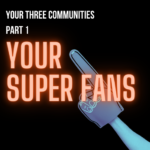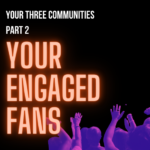 Greetings from Western Australia! As I type this I am in the backseat of a car driving from Perth to Margaret River to enjoy a day of wine tasting and beach before I teach a masterclass to local musicians. I have been invited here by The West Australian Music Industry Association to kick off their workshop series and have so far met and presented to over 200 musicians, labels owners, music industry students and managers. This is my third visit to Australia in 18 months and I love this country. I have been welcome here and have met lifelong friends and some of the most wonderful musicians (knows as “musos” in Aussie speak) on earth.
Greetings from Western Australia! As I type this I am in the backseat of a car driving from Perth to Margaret River to enjoy a day of wine tasting and beach before I teach a masterclass to local musicians. I have been invited here by The West Australian Music Industry Association to kick off their workshop series and have so far met and presented to over 200 musicians, labels owners, music industry students and managers. This is my third visit to Australia in 18 months and I love this country. I have been welcome here and have met lifelong friends and some of the most wonderful musicians (knows as “musos” in Aussie speak) on earth.
I’m not saying this to brag or boast, I am saying this to introduce and make a point about 1,000 true fans. Music Think Tank is read by not only artists but also by people who work in and who aspire to work in the music business.
As a hard working entrepreneur in today’s music industry, I constantly think about how I apply the 1,000 true fans philosophy to my business (just like every single artist I work with does). I am not a musician, and I don’t make a living creating music, I am viscerally aware of this fact, but I do make a living working with musicians and my dream to make a difference in their lives by the next generation of future leaders in my industry. My goals involve travelling the world and connecting with people to collaborate with. If I don’t connect well, I don’t get to live that dream.
So, why this intro? I am proud to be mentoring the next generation of young people who are interested in creating careers on the marketing side of the music business and I am off to Sydney next to do just this.
So without further ado, I introduce you to James Chatman from Sydney who I stumbled upon via a Google alert…. Here’s what led me to meet James.
I asked James if he would like to contribute to my “In Defense of 1,000 True Fans Series” from and Australian perspective and to my delight he has obliged. I spoke on a panel with Urthboy at APRAS Song Summit last June, so we agreed that he is the perfect artist to start off our series with…
In Defense of 1,000 True Fans – Down Under Series – Part 1: Urthboy
The 1,000 true fans theory has sparked much debate in the music industry. It polarizes people. Some believe that it’s the best model for success in this brave new digital world and others think that it’s an unrealistic and utopian viewpoint of the music industry. Personally, I’m a passionate proponent of the 1,000 true fans theory and believe that it often receives unwarranted criticism because people misunderstand it or approach it narrow-mindedly.
Before I go any further, I should introduce myself. I’m James Chatman, a young music marketer and online Publicist. Ariel Hyatt has given me the opportunity to research and contribute to her thought-provoking series “In Defense of 1,000 True Fans”. Ariel asked me to Australian study Australian artists as case studies for my articles. But before I introduce the case study for this article, I would like to articulate my personal opinion on the 1,000 true fans theory.
I have noticed that many artists remain sceptical about the 1,000 true fans theory. I think, a major reason for this is that many artists often pay too much attention to the figures and algorithms outlined within the theory instead of focusing on the fundamental philosophy behind it. Every single artist is subjected to different variables and financial circumstances, which will determine how many “true” fans are required to constitute a full-time living. Some artists, such as Matthew Ebel, can make a full-time living from as few as 40 true fans, whereas another artist may have 5,000 true fans. The point is, 1,000 is just a ballpark figure used to illustrate the fundamental idea behind the theory – it is not a definitive figure that will work for everyone. The fundamental idea outlined in the theory is that artists can make sustainable full-time incomes from their art if they endeavour to build meaningful, mutually beneficial and ultimately profitable, long-term relationships with their most diehard fans.
For some reason, many artists believe that they must abandon their dream of achieving mainstream success in order to follow the 1,000 true fans model. Many believe that you must choose to either go down the niche pathway or mainstream pathway. This is not true. It is absolutely possible to achieve mainstream success whilst simultaneously generating a sustainable income by meeting the needs of your “true” fans. All it takes is willingness. You can do it if you’re willing to spend some time every day engaging with your fans via social media, building up your mailing list and thinking of special ways to reward your most loyal fans. At the same time you can pursue mainstream success by touring, playing festival circuits, networking, seeking radio airplay and selling music to as many people as possible. If you don’t have enough time to do everything – then hire someone (even a friend) to help you! Your music career is your business – you need to make investments and take risks, otherwise you’ll never get anywhere.
The cold hard fact is that very few artists ever “make it big”. Mainstream success is extremely difficult to achieve. Mainstream success is determined by popular culture, trends, industry connections, hard work and just plain luck. If you set out simply to achieve mainstream success and do not build meaningful, and consequently profitable, relationships with your most loyal fans, you will lose everything if you don’t “make it”. This seems like a risky strategy to me. Why not follow a model where you have a safety net? By nurturing your “true” fan base, you can ensure that you have a community of loving supportive fans who will back up your dream if you don’t ever get that top 10 hit you dreamed of.
Now let’s move on to my first case study. For this article, I interviewed Australian artist, Tim Levinson, to see what he had to say about the 1,000 true fans model and how it applies to Australian artists. Tim is best known for being a member of Aussie hip hop group ‘The Herd’. Tim is also a solo hip hop artist under the alias of Urthboy and label manager at Elefant Traks.
James Chatman: Do you think the 1000 true fans theory works?
Tim Levinson: It does – although this definition of “true” fans seems to me to be borderline obsessive fans (multiple copies of the same release; Google alerts for your name etc). This means you’ve got your crazies (bless em!) buying everything and possibly stalking you – while the great majority of ‘untrue’ or ‘come and go’ fans only buying your stuff if you’re on radio and popular. Therefore a band is going to be seeing pretty good money overall if they’re in this predicament. The way it’s defined in the theory is a pretty wild exaggeration of the kind of fans I’ve been lucky to have. In a population like America it’s possible you’ll have a 1,000 people who’ll travel 200 miles to see you – it’s not the same in Australia. There are also expenses and possibly commissions to be considered when calculating that 1,000 people spending $100 each is $100k income. That’s not profit, that’s gross revenue before tax.
A band works for years to build a reputation – this is the key to the 1,000 true fans – they then need to consistently release new music, merch and tours to maintain this income – this is often unsustainable over many years. Highly motivated people maybe, but a lot of musicians find this difficult in numerous ways (inspiration, sense of purpose, personal predicament, delays receiving revenue and simple inevitable things like getting older).
This theory is accurate for relatively well-established bands/artists for a temporary period of time in their careers.
JC: Can you give us a breakdown percentage wise of the following:
TL: I can only give you a rough estimate here.
A. CD sales? 10%
B. Subscription site? NA
C. Live shows? 33%
D. Merchandise? 2%
E. Film & TV? 12%
F. House Concerts / Private Shows? N/A
G. Bundles of products / Special Offers? 4%
H. Other (please specify?)
Label Manager 30% Consultancy work 9%
JC: How many die-hard fans would you (as a solo artist) say you have – fans that will buy everything and anything from you?
TL: This is difficult to answer, but an educated guess would be around 300 – 400.
JC: Do you earn enough money from your solo music to constitute a full-time living?
TL: Yes I have been able to do this for a few years, although I’ve always worked in various music business capacities alongside my creative work.
JC: How do you go about attracting “true fans?” What are some specific things that you’ve done to turn surface listeners and casual social media friends into lifelong fans?
TL: The thought of consciously attracting or turning people into lifelong fans concerns me because it reveals an agenda that overshadows genuine interactions with fans. The main incentive for a fan is a real connection with your music – everything after that is about trying to treat people with the same respect that you’d want to be treated. I get annoyed when I’ve engaged an artist a few times on Twitter and received no response – so I take this into consideration when engaging with my fans. If people have given me their time by buying tickets etc, I try and make time for them at the gig – I try and respond to them online. This is all relative, it’s not easy if I’m really tired or busy or my voice is damaged.
JC: How do you use analytics to your advantage? What are your measurable online results, and how do your measures help you with your music career?
TL: I run a business where it’s not all about me (!), so I don’t analyse enough. I do use analytics a bit but it’s mainly around budgeting for ALL of our business activity so we can continually adapt as consumers do. ‘Business as usual’ in a changing musical environment is a sure fire way to waste precious resources.
JC: In your opinion, which social network is the most valuable to musicians? Why?
TL: At this stage I’d have to say facebook as it works far better as a fan platform: it retains info, photos, links, bios, music (however clunky their player is). Not only is it the most widely used social media but the extra space (i.e. more than 140 characters) allows bands to write more. I also find it’s easier for a band to have management handle their facebook account than it is Twitter. I can’t stand artists on Twitter having their management do their tweets – I didn’t follow them to hear someone else. It’s very useful to dip your toes in the social media pool and find out how things work and what feels best for you – but no artist needs to be constantly across all platforms, that’s a waste of your time.
JC: You’re a prolific Twitter user. How has Twitter helped you and what would you say to musicians who doubt its usefulness?
TL: Twitter is my fave communication tool online (other than email), it’s more of a level playing field in my experience – less self-promotion tolerated – and it’s ok to post numerous updates. You can follow and unfollow like you’re changing TV channels and I’d prefer the musings and links of an unknown person than the self-absorbed views of someone famous. In this way there is a greater need for bands to bring something to the table, which in turn enriches the public interaction. Of course the more popular you are the more people will follow you – but that’s not the spirit of Twitter in my opinion.
JC: Myspace recently closed down its Australian office. Is Myspace still a useful tool for musicians or has it been superseded by Facebook?
Yes and no. Myspace is dead but the music industry is determinedly old fashioned and many decision-makers still use it as a research resource. Having hundreds of millions of users has obviously made Facebook supremely arrogant because their music player is horrible and clunky. Myspace would be in a virtual museum if Facebook was willing to put their users ahead of their obsession with controlling information.
JC: Have you set any specific goals and/or objectives for your social media activity? If so, do you mind sharing them with us?
TL: We all have unique thoughts every day – they spring up during conversations and random moments and they make great social media material. Unfortunately when you’re sitting at the computer trying to squeeze out a nugget of genius it doesn’t play ball. I don’t set goals like this but if you want to do social media better, its worthwhile noting the ROFL LOL FTW! SMH OMG thoughts down as they occur.
JC: Do you integrate your online and offline efforts to nurture your fan base? For example, do you promote your mailing list or social media sites at live shows?
TL: Definitely. Reach people however you can – especially after they’re smiling ear to ear after a show.
JC: What have you done to compensate for the reduction in income from retail CD sales resulting from free peer-to-peer downloading?
TL: Our online store is a concerted effort at maximising revenue from sales and also adding a personal touch. We actually pack the CD that you buy from our store. We can’t control the death of retail – and the strategy of manufacturing deluxe packages to encourage physical sales has merit but at significant cost, putting yet more pressure on recoup.
JC: Do you only write/play music that you like or do you tailor your music to meet the needs of your core fans? How important is it to strike a balance?
TL: I write music to satisfy my own curiosities. I do have a ballpark understanding of what’s expected but life is way too short to second guess your audiences expectations. Every human grows and subtly evolves and music is no different – if this means losing some fans then that’s ok. If this means losing a LOT of fans then perhaps the artist needs to consider if they’re doing the right thing. I’m far more excited by a new Radiohead LP than a Muse LP.
JC: In your opinion, is it possible to meet the needs of a smaller core group of fans whilst simultaneously reaching out to a wider audience in pursuit of mainstream success?
TL: Those smaller core groups of fans are very important – but they’re not band leaders. A band needs to pursue their own goals and do their best at respecting those fans in the process.
The thing that strikes me most about Tim is his attitude towards his fans. His first priority is to show respect to his fans instead of simply looking at them as cash cows. This allows fans to truly connect with his music. Tim endeavours to reciprocate the love shown to him by his fans and believes in using social media to engage in genuine two-way conversations. His comment “I can’t stand artists onTwitter having their management do their tweets – I didn’t follow them to hear someone else” strongly resonates with me. His attitude to fan building clearly reflects the 1,000 true fans model.
The only point he makes that I don’t fully agree with is: “This theory is accurate for relatively well established bands/artists for a temporary period of time in their careers.” I believe the 1,000 true fans model applies to all musicians who are striving to make a living from their music, regardless of career stage. New artists need to build a loyal fan base to help them establish a reputation and to make it to the next stage of their careers, and mature artists need a loyal fan base to sustain their incomes.
In conclusion, I think it’s fair to say that Tim Levison is a great example of an artist who understands the benefits of building meaningful relationships with fans. Tim’s answers support the fact that the most valuable part of the 1,000 true fans model is the fundamental philosophy behind it – that artists can make sustainable full-time incomes from their art if they endeavour to build meaningful, mutually beneficial and ultimately profitable, long-term relationships with their fans. Tim also shows that it’s possible to adopt this philosophy whilst simultaneously pursuing mainstream success (he has maintained a loyal fan base of 300-400 fans whilst also achieving mainstream success in Australia). However, as Tim says, artists need to “consistently release new music, merch and tours to maintain this”. The 1,000 true fans model clearly requires dedication, hard work and patience.
But that’s just life isn’t it?
Hangout with Tim / Urthboy:
@urthboy
http://www.facebook.com/urthboy
Hang out with James Chatman:
Hang out with Ariel
http://www.facebook.com/CyberPR
Read some other installments of Ariel’s “In Defense of 1,000 True Fans” right here on Music Think Tank.











